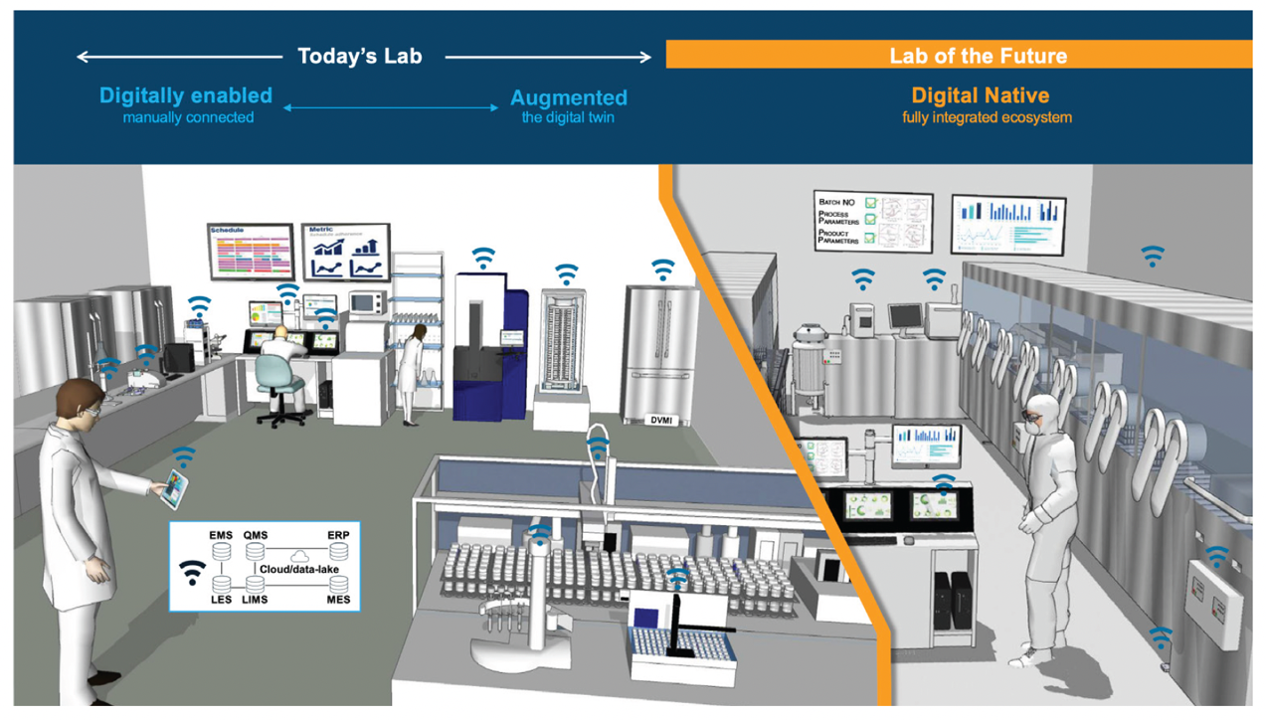Inside the Lab of the Future: How Advanced Technologies and Optimized Lab Informatics Can Turn Scientific Data into a Valuable Business Asset
Alan Marcus
Chief Growth Officer
LabVantage Solutions, Inc.

The Lab of the Future Isn’t About Digital Tools. It’s Not Even About Labs.
The lab of the future is about the whole enterprise. It generates business value by using advanced digital tools and techniques to make contextualized, actionable scientific data available at the bench, in the executive boardroom, and wherever that data can help generate revenue, accelerate innovation, and drive meaningful business decisions.
The goal of building a lab of the future isn’t simply to eliminate paper or implement a new digital tool. It’s to prepare your enterprise for long-term flexibility and growth when your identity as a research company, a diagnostics company, an oil and gas company, a consumer-packaged goods company — however you identify your business position — is no longer enough. To compete in today’s crowded marketplace, you must also become a tech company. And to do that, you need to recruit the lab as a key driver of innovation and insight.
In other words, your lab needs to evolve into a lab of the future. Companies like yours are already working alongside scientific data advisors to prepare for that evolution.
The Benefits of an AI-Driven, Interconnected Lab of the Future are Far-Reaching
Establishing and growing a lab of the future is a complex undertaking. It requires significant expertise in data orchestration and an ongoing investment in the best and most advanced tools and technologies available. What makes all of this time, effort, and continuous striving worthwhile? The answer is important, and it has implications for individual enterprises, the customers they serve, and the world as a whole.

The lab of the future — Instead of remaining locked inside a LIMS, the lab of the future leverages advanced technologies to make scientific data available, actionable, and immediate for the right people at the right time.
The optimized company — Meaningful, machine-enabled analysis helps company leadership teams identify important lessons, insights, warnings, and opportunities coded inside scientific data, which guides their decision-making process and empowers them to outpace competitors and navigate marketplace complexities with confidence.
Partnership ecosystems — As companies learn how to access, contextualize, and instrumentalize huge volumes of scientific data, new practices and standards will emerge to enable and incentivize collaboration between partners. The lab of the future will play a central role in this collaborative era, enabling multidisciplinary research and discovery.
Customers and patients — The lab of the future will help drive positive outcomes by delivering the precise diagnostics, advanced therapies, and high-quality, sustainable goods that patients and customers need to live healthy, meaningful lives.
Real solutions for global problems — This push for a collaborative, data-driven future will help companies across industries address humankind’s most complex and dynamic problems: food insecurity, energy crises, climate change, medical-related shortages, supply chain issues, and much more. To overcome these problems, we need innovative solutions — and to find those solutions, we need labs of the future today.
Five Key Principles Behind Every Lab of the Future
In order to deliver on the promises outlined above, architects of the lab of the future must base their vision around a few core principles. These principles are the foundation on which every lab can build their future success; like north stars, they will steer you from your current position on the digital transformation spectrum toward a fully integrated lab ecosystem that’s purpose-fit for your company’s objectives.
Transitioning from a paper-based lab to a lab of the future generally involves three major phases: (1) moving from paper-based records to a LIMS and adopting some digital capabilities, (2) moving to augmented lab workflows and leveraging digital twins to simulate and predict lab outcomes, and (3) establishing a fully integrated data ecosystem within a digitally native lab. Understanding the principles that drive each phase can help labs accelerate their transformation.

FIRST PRINCIPLE
In a lab of the future, data is at the forefront of building intelligence
For a lab at the beginning of their digital transformation journey, applying this principle could mean moving from manual data management to a LIMS; as they move deeper into their transformation, this principle means connecting all lab systems — their LIMS, ELN, LES, and SDMS — into an optimized informatics landscape. From there, labs can integrate tools like artificial intelligence into their data strategy, which can enhance both upstream data capture and downstream data analysis in ways that simply aren’t possible with siloed systems and human interventions alone.
SECOND PRINCIPLE
A lab of the future maximizes interconnection and automation
In a lab of the future, instruments exchange data and interface seamlessly with lab systems, freeing operators from repetitive data-related tasks and reducing the risk of lost productivity due to human error.
THIRD PRINCIPLE
A lab of the future purposefully adopts today’s best digital tools
When it comes to leveraging artificial intelligence and other best-in-class tools and techniques, you won’t hear leaders of a lab of the future using phrases like “we thought we’d play around with it” or “let’s just test it out.” Instead, they are deeply committed to sharpening their competitive advantage by tactically and strategically putting today’s proven and emerging technologies to work in a commercially meaningful way.
FOURTH PRINCIPLE
A lab of the future delivers accurate intelligence in real time
In today’s accelerated post-2020 world, labs can’t afford to wait even a few minutes for a data dashboard to update. From accelerating research and clinical development to moving products to market at warp speed, companies and the customers and patients who rely on them need smart, real-time analytics. The lab of the future remedies this by delivering immediate insights that lab operators across R&D and Quality can trust.
FIFTH PRINCIPLE
Company leaders can measure the ROI of their lab of the future
To take your lab to a new level, you need to know exactly how your investment in digital- ization will pay off. The lab of the future, whose design and operation is predicated on intelligence-driven systems, helps corporate leadership measure this ROI transparently,predictably, and accurately. That’s the beauty of freeing scientific data from the “black box” of lab systems and integrating it into the enterprise data lake — not only does it help the lab plan its next best steps, it helps the organization as a whole make strategic, knowledgeable investments in the future of their operation.
The role of artificial intelligence, machine learning, and other advanced technologies
AI and other advanced technologies can advance science and lead to better outcomes – whether reducing risk in quality labs or accelerating discovery in pharma R&D. How?
By giving lab staff, from technicians to investigators to data scientists, the ability to accomplish in seconds what used to take hours, days, or even weeks. Previously impossible tasks are now possible with AI:
- Improve operational performance by predicting and proactively preparing for demands of laboratory resources
- By analyzing vast amounts of data faster than humanly possible, surface potential new treatments much faster
- Identify patterns and correlations in complex datasets that may not be apparent to human researchers; gain insights from incomparable datasets
- Analyze past or real-time operational data to predict future risk of failure or out-of-spec results
- Automate everything from scheduling and risk assessment to sample preparation and processing
In one use case, AI and machine learning (ML) returned more than five times a company’s investment in just three years by delivering automated processes with 97% quality and immediately reducing the processing time for “bad” batches.
How to Position Your Lab for the Future
Every lab has to define their own unique pathway from their current state to the digitally advanced, data-driven ideal. Your company’s business objectives, your competitors, your position in the marketplace, your current and aspirational capabilities at the bench — each of these factors and many others will determine exactly when and how you should advance through successive phases of digital transformation. In our experience, the smoothest and most effective transformations start with a common first step.
Find a Scientific Data Advisor That Understands Your Vision
What is a scientific data advisor?
A scientific data advisor is someone who recognizes the complex path between lab-generated insights and enterprise-level decision-making, and who has the skills and experience to grease that path using today’s most advanced technologies.
As your bench-to-boardroom expert, your scientific data advisor will help you establish a modern informatics strategy in the lab while working alongside your ERP or CRM advisors at the enterprise level. Their goal is to ensure that your company’s decision-makers can access, understand, and — most importantly — use your lab data to drive your business forward.
What should you look for in a scientific data advisor?
Look for someone with a background that goes beyond buzzwords. An effective scientific data advisor has spent years not just talking about digital transformation, but actually making it happen. They’ve helped companies like yours outperform competitors by revolutionizing their labs from the inside out, using the right digital technologies, the right data architecture, and the right future-facing mindset to make real and meaningful change happen at the core of the business.
Most importantly, a strong scientific data advisor is committed to evolving in step with tomorrow’s technologies. As new capabilities emerge, like AI-driven approaches to semantic search or novel applications for intelligent instruments, they’re already at the front of the wave, using, testing, and tailoring that technology so you can get the most from it, in the most efficient way.
How can a scientific data advisor help you take your next steps toward establishing a true lab of the future?
A good scientific data advisor will tailor their approach according to your business drivers, your current level of lab digitalization, and many other factors. That tailored approach might include:
- Helping you establish an end-to-end data ecosystem in your lab, aligning R&D activities to QC testing and every step in between.
- Identifying untapped business value in your lab data and establishing the technological and operational protocols necessary to bring that value into the boardroom.
- Integrating artificial intelligence and machine learning into the lab in an effective and rationalized way.
- Solving scientific data lake challenges across the organization to develop a more harmonized, centralized approach to collecting and instrumentalizing lab data.
Where do people belong in a Lab of the Future world?
Within all the hype that surrounds discussions of digital transformation and labs of the future, you’ll often find an undercurrent of anxiety: what will happen to human operators as labs strive for more automation, digitalization, and efficiency?
Here’s the thing: when it’s undertaken responsibly and aligned with a realistic, sustain-able vision of future success, building a lab of the future is not about replacing people in the lab — it’s about freeing those people from repetitive, arduous tasks so they can take on higher-value work.
Given that demand for lab scientists is actually increasing (the Bureau of Labor Statistics expects employment of medical scientists to grow by 17% over the next several years1), now is the time to make these changes. Instead of preparing samples, entering data, generating CoAs, and managing inventory, operators in a lab of the future are busy applying their skills and experience where they have the greatest impact: driving innovation, achieving scientific breakthroughs, and building close alignment between lab objectives and the overall needs of the company and its customers.
From Aspiration to Success Story
What matters most is your vision of the lab of the future. That vision won’t come from a white paper — it will come from within your company. The key: find scientific data advisors who will take the time to really understand that vision, and who have the skills to help you achieve it.